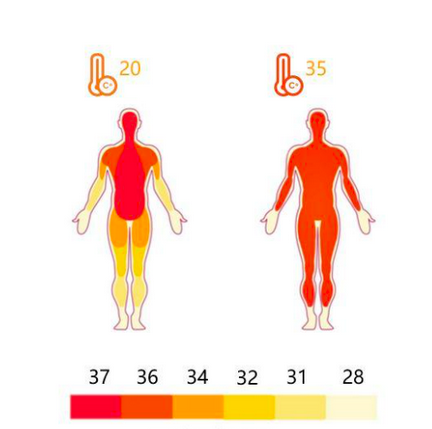The advanced center of body temperature regulation is the hypothalamus. The medulla oblongata, spinal cord and other parts are also involved in the integration of part of the body temperature regulation information and carry out physiological regulation. The cerebral cortex is involved in the behavioral regulation of body temperature, such as rubbing hands, stomping feet, adding clothes, etc.

Core Temperature (◦C)
The ideal temperature of the human body is 37 ◦C. When the temperature is above 40.5 ◦C, the biological enzymes in the body will be ineffective, making the body's chemical reaction difficult to carry out, which can lead to death. However, if exposed to a cold environment for a long time, the body's heat loss is greater than the heat supply, which will cause the body's temperature to drop and threaten life.
What conditions can cause loss of temperature? Many people think that loss of temperature is cold, which is caused by low temperature. This is true. Low temperature is indeed an important cause of temperature loss, but it is not all.
The normal body temperature of the human body is 37°C, which is a heat source in itself, so it also conducts heat transfer with the outside world. When the wind blows, it transfers heat to the outside world through convection. When swimming, the body heat transfers heat to the water through conduction. Even if the body is stationary, it transfers heat to the outside through radiation.
According to these three heat transfer methods: temperature, humidity, and wind, these three factors are the most common direct causes of temperature loss. As long as two of the three factors appear, problems may arise. The temperature is at least about 10°C. According to the experience of ordinary people, it is unimaginable that such a temperature will lose temperature. However, if a person is soaked in the body during exercise, the wind is strong on the mountain, and the moving air constantly removes the heat from the body surface. This "air-cooling effect" makes the body temperature lower than the actual temperature when there is wind. In the end, it can also cause severe hypothermia.
People die from hypothermia, which is what we usually call freezing to death. The process can be divided into four phases: excitement phase, excitement weakening phase, inhibition phase, and complete paralysis phase. The periods are not completely separated, but continuous with each other.
Of course, it can also be classified in this way, first-level mild hypothermia: 33-37°C; second-level, moderate hypothermia: 29-33°C; third-level, severe hypothermia: 22-29°C; fourth-level, Fatal stage: below 22°C.
When the body temperature drops to about 36 ◦C, the body is in the initial cold environment, the nervous system is in a state of excitement, the body's blood is redistributed, and the blood flows to the deeper layers of the body to reduce the loss of heat. People experience increased breathing rate, restlessness, and blood pressure. High, chills and other stress responses.
As the temperature drops further, when the body temperature drops to about 34 ◦C, the cerebral cortex is in a period of inhibition, the cerebral cortex loses its function of regulating and controlling body temperature, the blood vessels of the skin expand, and the warm blood in the deep layers of the body fills the blood vessels of the skin, causing the internal temperature of the body to drop Faster, the body surface temperature drops slowly, causing a transient body surface and internal body temperature to be equal or close, you will find that your breathing and heart rate slow down, and you no longer feel painful stimulation.
And when the body temperature drops to about 28-20℃, your reaction will become dull, even hallucinations, and start to become particularly sleepy. This means that you have begun to fall into a coma, and finally your pupils will dilate and appear. suspended animation.
At this time, the human body's ear helix, earlobe, nose tip, fingers, calf, heel, back of toes, etc. will develop frostbite or even be frozen. This is part of the human body sacrificed to survive.
However, after freezing to death, the cold sensory center in the body temperature center is paralyzed, the cold sensory disappears, and the whole body is paralyzed. At this time, although the body temperature is dropping, the skin receptors feel hot. This is because the hypothalamic body temperature regulation center is at this time It has failed, and a wrong judgment was made. The heat signal from the hypothalamus thermoregulation center is transmitted to the receptors, which causes the surrounding blood vessels to dilate, and a large amount of blood flows to the skin capillaries, so that you in a low temperature environment will have a different kind of reality. The incompatible heat sensation leads to the phenomenon of "unusual undressing" before freezing to death.

